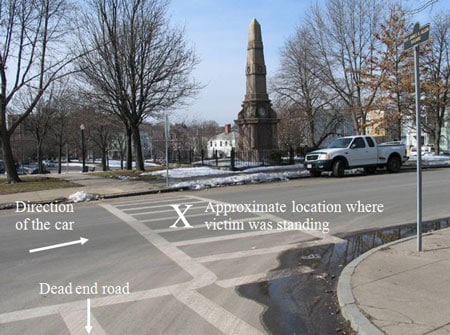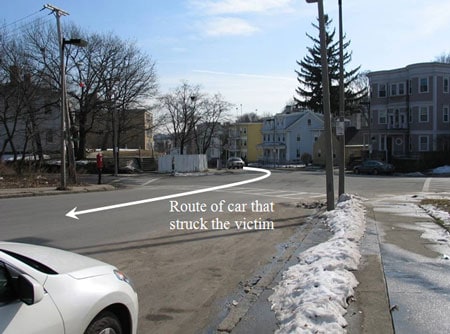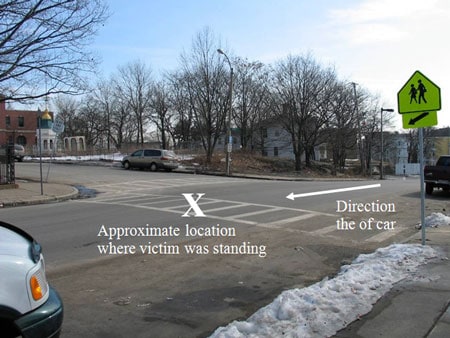School Traffic Supervisor was Fatally Injured when Stuck by a Motor Vehicle - Massachusetts
Massachusetts Case Report: 08-MA-046
Release Date: July 14, 2009
Summary
On October 21, 2008 a 58-year-old female School Traffic Supervisor (victim) was fatally injured when she was struck by a motor vehicle while assisting a child in crossing a roadway. The victim walked into the roadway crosswalk and signaled for all traffic to stop. As the student stepped into the crosswalk and started crossing, the victim noticed a motor vehicle quickly approaching. At this point, the victim realized that the motor vehicle was not stopping and the child was going to be struck and got the child to stop. The victim was then struck by the motor vehicle. After striking the victim, the operator of the motor vehicle drove a few hundred feet before stopping. Multiple people placed calls for emergency medical services (EMS). EMS, police and fire department personnel arrived within minutes and transported the victim to a local hospital were she died eight days later. The Massachusetts FACE Program concluded that to prevent similar occurrences in the future, municipalities should:
- Develop a school route plan that meets the standards set forth in the national Manual on Uniform Traffic Control Devices (MUTCD);
- Ensure that school crosswalks are clearly visible to motorists;
- Ensure that the design of equipment supplied to workers, such as stop paddles, does not prevent employees from using the equipment; and
- Ensure that School Traffic Supervisors are provided with refresher training, at a minimum, every three years.
Introduction
On October 21, 2008, the Massachusetts FACE Program was alerted by the local media that earlier that same day a female School Traffic Supervisor was in serious condition after being struck by a motor vehicle while assisting a student in crossing the street. Eight days later the Massachusetts FACE Program was alerted by the local media that the School Traffic Supervisor had died from her injuries. An investigation was initiated. On February 11, 2009, the Massachusetts FACE Program Director traveled to the employer location and the local police department, and met with a police department representative to discuss the incident. The police department report, death certificate, and other School Traffic Supervisor fatality reports were reviewed during the course of the investigation. In addition, the incident location was photographed.
The employer is a municipal police department for a large Massachusetts city with more than a half million residents. The police department is divided into multiple districts and has been protecting the city’s citizens since the late 1800’s. The department employs a total of 401 School Traffic Supervisors that are assigned throughout the districts. Thirty-three School Traffic Supervisors are assigned to the same district as the victim. School Traffic Supervisors work 15 hours per week, which are divided into two shifts per day, Monday through Friday. Each shift is one and one half hours long, although the victim usually arrived early and stayed late to make sure all students were on their way home safely. The start time for the morning shift ranges from 6:00 a.m. to 9:00 a.m. depending on the location being covered. The afternoon shift start time ranges from 1:00 p.m. to 3:00 p.m. The victim had been employed as a School Traffic Supervisor at the same district and assigned to the same crossing location for eight years.
The department provides every School Traffic Supervisor training prior to being placed in the field. The training consists of written materials, a video, and pre and post written tests. One of the written materials is a School Traffic Supervisor-specific training manual that the police department developed with the help of the American Automobile Association. The department provides a yearly clothing allowance of $450 that the School Traffic Supervisors use to buy clothing and personal protective equipment (PPE). The clothing allowance is issued to the School Traffic Supervisors once a year in October. School Traffic Supervisors are supplied with two police badges, to be placed on their hats and their jackets or shirts. The School Traffic Supervisors have union representation at the department.
Investigation
The school closest to the crossing location where the victim was assigned is an elementary school for students in kindergarten through fifth grade. The school has approximately 500 students in attendance and is located on a relatively short dead-end roadway that runs east and west. The east end of the dead-end roadway is where the school is located and the roadway begins at the west end at a T-shaped intersection (Figure 1). There is a stop sign facing the motorists that are traveling west on the dead-end roadway towards the T-shaped intersection. A park is located on the opposite side (west side) of the intersection from the dead-end road. This T-shaped intersection is the crossing location where the victim was assigned. The other roadway that makes up this T-shaped intersection runs north and south and is a more heavily traveled main roadway.
Both roadways handle two-way traffic and are approximately 56 feet wide, but do not have center yellow divided lines. The roadway’s painted markings consist of white fog lines at the edges of the roads and crosswalks. There are two white painted crosswalks at the T-shaped intersection. The two painted crosswalks have two white parallel lines that run the width of the roadway and white longitudinal lines that are parallel to traffic flow. One of the crosswalks is located at the west end of the dead-end roadway at the T-shaped intersection. The other crosswalk is located on the main roadway at the northern side of the T-shaped intersection. The latter is the crosswalk the victim was located in at the time of the incident (Figure 1). A few hundred feet south of the T-shaped intersection is a skewed four-way intersection where there are no stop signs and traffic travels quickly up to and through the intersection (Figure 2).
On the day of the incident, the victim had arrived to the crossing location at 7:00 a.m. and the incident occurred approximately one hour and 45 minutes later. The victim had been wearing fluorescent yellow-green reflective coat, pants and gloves. The victim was also wearing a white hat and had a whistle. The weather was cloudy with an outdoor temperature around 50 degrees Fahrenheit.
Prior to the incident the victim had finished crossing a group of students from the park location, eastward across the main road. Once the students were on the sidewalk, the School Traffic Supervisor stayed on the sidewalk with the students to attend to a student. When finished attending to the student the School Traffic Supervisor noticed that another student had crossed through the park and was at the edge of the roadway waiting to be crossed. The victim stepped into the crosswalk while signaling for all traffic to stop. The victim walked to the middle of the roadway within the crosswalk and the student started crossing. The victim then noticed a motor vehicle, a passenger car, traveling on the main roadway heading north towards the T-shaped intersection (Figure 3). This motor vehicle had previously turned right at the skewed four-way intersection onto the main roadway where the victim was positioned.
At this point, the student was nearing the middle of the roadway. Realizing that the motor vehicle was not going to stop, the victim yelled to the student to stop, which they did. The motor vehicle continued in the northerly direction and struck the victim. Although the exact speed of the motor vehicle was not known, multiple witnesses estimated the speed to be 23 – 25 miles per hour. After striking the victim, the elderly operator of the motor vehicle traveled a few hundred feet beyond the intersection before stopping. Multiple calls were placed for emergency medical services (EMS). EMS, police and fire department personnel arrived within minutes and transported the victim to a local hospital were she died eight days later.
Since the incident, the city has installed three fluorescent yellow-green school crosswalk signs. One of the signs is located on the south side, facing traffic traveling west on the dead-end roadway toward the T-shaped intersection. The other two fluorescent yellow-green school crosswalk signs are located on the main roadway. One crosswalk sign faces traffic traveling north on the main roadway just beyond the intersection near the crosswalk where the incident occurred. The other faces traffic traveling south. Two of the three fluorescent yellow-green school crosswalk signs have the supplemental diagonal downward pointing arrow showing the actual location of the crosswalk. This combination of the two signs is called a school crossing sign assembly. The school crosswalk sign that does not have the diagonal downward pointing arrow was the sign located on the main roadway facing traffic traveling north, the same direction the motor vehicle that struck the victim was traveling.
The recommendations below were developed for employers of School Traffic Supervisors. The topic of elderly driving is beyond the scope of this Program and investigation and therefore not addressed in this report. In addition, it should be noted that Massachusetts General Law, Chapter 89: Section 11 states that drivers of vehicles shall yield the right of way, slowing down or stopping if need be so to yield, to a pedestrian crossing the roadway within a crosswalk.
Cause of Death
The medical examiner listed the cause of death as blunt impact of head with subdural hematoma.
Recommendations/Discussion
Recommendation #1: Municipalities should develop a school route plan that meets the standards set forth in the national Manual on Uniform Traffic Control Devices (MUTCD).
Discussion: A first step in developing a school route plan is to evaluate the area around the school. Participants developing a school route plan should include the school, law enforcement, and traffic officials responsible for school pedestrian safety. The school route plan should consist of a map showing roadways, the school, existing traffic controls, established school walk routes, and established school crossings and the specific traffic control devices.1
In this case, an evaluation of the area around the school, that included these two crosswalks, might have revealed that traffic control devices were needed to make the area safer for students and School Traffic Supervisors. The school crosswalk where the victim was assigned had no traffic control devices at the time of the incident. Since the incident, three traffic control devices have been installed: two fluorescent yellow-green school crossing sign assemblies; and one fluorescent yellow-green school crosswalk sign.
As recommended by the Manual on Uniform Traffic Control Devices (MUTCD) the signs posted at school crosswalks should include the school crosswalk sign supplemented with a diagonal downward pointing arrow showing the location of the crosswalk (school crossing sign assembly).1 In this case, a diagonal downward pointing arrow sign should be added to the fluorescent yellow-green school crosswalk sign on the main roadway facing motorists traveling north to make a complete school crossing sign assembly.
The MUTCD also recommends using school advance warning sign assemblies in addition to school crossing sign assemblies. School advance warning sign assemblies consist of two signs: a school crosswalk sign; and a supplemental “AHEAD” sign or a sign showing the distance until the crosswalk posted below the school crosswalk sign. School advance warning sign assemblies should be posted in advance of the school crosswalk sign assemblies and facing traffic approaching the crosswalk from either direction.1
Recommendation #2: Municipalities should ensure that school crosswalks are clearly visible to motorists.
Discussion: In this case, prior to the incident there were no signs indicating the school crosswalk or other traffic control devices. Since the incident, some fluorescent yellow-green school crosswalk signs have been installed in the area. Municipalities should evaluate school crosswalks to ensure that they are as visible as possible to motorists. Some options to help increase the visibility of school crosswalks and catch the attention of motorists include:
- Permanent signs with flashing lights that would be in use during the commuting time to and from school.
- In-pavement roadway warning light systems. The lights for these systems are embedded in the pavement along each side of the crosswalk.2
- Portable in-street pedestrian crossing signs or barrels.
- School crosswalks that are freshly painted and not faded.
- Raised crosswalks that bring the roadway up to the level of the sidewalk. Raised crosswalks improve the visibility of the crosswalk and pedestrian, and act as a speed hump resulting in reduced vehicle speeds.3
In addition, the vegetation in the area should be kept trimmed to ensure that it is not overgrown and blocking motorists view of the school crosswalk.
Recommendation #3: Municipalities should ensure that the design of equipment supplied to workers, such as stop paddles, does not prevent employees from using the equipment.
Discussion: The MUTCD recommends stop paddles as the primary hand signaling device.1 In this case, the School Traffic Supervisors were supplied with stop paddles. These particular stop paddles were heavy and the handles/support sticks were small, making the paddles difficult to use and maneuver. Therefore the paddles were not routinely used by the School Traffic Supervisors. If the paddles were lighter and had a better designed handle, they would have been less awkward to use. Use of a stop paddle in this case might have enhanced the visibility of the victim as she was positioned in the middle of the school crosswalk, and would have provided a clearer warning to the driver of the motor vehicle to stop.
In addition, light-emitting diode (LED) stop paddles are available. These stop paddles with flashing LEDs will increase the paddle’s visibility range, day or night, which should result in drivers noticing them further in advance than conventional stop paddles.4
Recommendation #4: Municipalities should ensure that School Traffic Supervisors are provided with refresher training, at a minimum, every three years.
Discussion: There was very low turn over of School Traffic Supervisors for this district. All School Traffic Supervisors were provided with specific training prior to being placed in the field, which consisted of written materials, a video, and pre and post written tests. The department had a training manual that was provided to all School Traffic Supervisors. It was reported that in 2008 the department had tried to provide refresher training but the training did not occur. The department should support and ensure that School Traffic Supervisors are provided with refresher training which occurs, at a minimum, every three years.
It should be ensured that the training materials are routinely reviewed and updated prior to providing the refresher training. This will ensure that all trainings are updated and include newly recognized hazards and newly implemented equipment. School Traffic Supervisors should be included in the process of reviewing and updating the training materials. In addition, a review of the materials and training should be performed after an incident or near-miss incident.

|

|

|
|
Figure 3 – Incident location with a school crossing assembly sign added after the incident.
|
References
- U.S. DOT 2009. Manual on Uniform Traffic Control Devices (MUTCD)pdf iconexternal icon, 2009 Edition, U.S. Department of Transportation Federal Highway Administration. http://mutcd.fhwa.dot.gov/pdfs/2009/part7.pdf. Date accessed: 1/4/2010.
- Institute of Transportation Engineers. Institute of Transportation Engineers Pedestrian Award Program 2003pdf iconexternal icon. City of Glendale, California. www.ite.org/activeliving/files/C-2-C_ppa002.pdf.
- Massachusetts General Laws, Chapter 89: Section 11. Marked crosswalks; yielding right of way to pedestrians; penaltyexternal icon. https://malegislature.gov/Laws/GeneralLaws/PartI/TitleXIV/Chapter89/Section11. Date accessed: 1/4/2010. (Link Updated 8/13/2013)
- ATSSA 2006. Putting Safety in the Safe Routes to School Program. A Schools Administrator Guide. American Traffic Safety Services Associationpdf iconexternal icon. www.atssa.com/galleries/default-file/SRTSAdminGuide.pdf.
To contact Massachusetts State FACE program personnel regarding State-based FACE reports, please use information listed on the Contact Sheet on the NIOSH FACE web site Please contact In-house FACE program personnel regarding In-house FACE reports and to gain assistance when State-FACE program personnel cannot be reached.
